Self Mastery
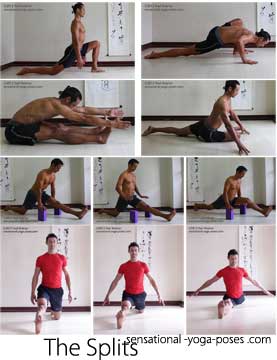
For myself, self mastery not only means mastering my relationship with my body, but also mastering the relationship between myself and my environment.
In both cases the thing that I change is myself.
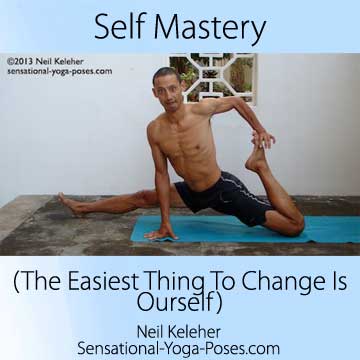

For myself, self mastery not only means mastering my relationship with my body, but also mastering the relationship between myself and my environment.
In both cases the thing that I change is myself.

I was reading the facebook post of a friend who'd moved back to Canada from Taiwan
He's posted a few times about various non-complimentary aspects of Canadians.
For myself I remember my first few years in Taiwan (and even now on occasion) things like people jumping queues or pulling out in traffic without looking behind them used to cheese me off. I realized the only thing that I could do, if I wanted to not be continually cheesed off, was to change myself and the way that I did things.
A lot of the times when the actions of others caused me to get pissed off I realized it was because I hadn't been paying attention. And so I started looking further ahead while driving, expanded my awareness outwards so that I could see what was about to happen before it happened. I could then respond, slowing down or speeding up or steering around the obstacle with minimum effort.
Rather than thinking (or saying) "asshole" I carried on smiling because I was able to keep on flowing. I gave myself room and I gave that other person room too and life was good.
Then there have been the times when I was the asshole. I've pulled out without looking, forgetting what I was doing and I've been lucky enough in most instances that nothing has happened.
When I was younger, still in high school, I used to swear alot. I remember a teacher was driving me and another student to a competition and I unconsciously swore. I didn't even know that I swore and wondered why the teacher looked back so suddenly. My friend then told me that I'd just said the F-word.
Later on I decided that I would stop swearing. Or at least gain control of it. I started by noticing when I was swearing, often after the fact. And I'd change the "F" word to frig, or the "S" word to sugar.
Later on I began to catch myself as I was swearing and so I could change the word before I said it. After a few weeks (or perhaps months) I was able to notice when I was going to swear and then stop myself.
I still do swear now, but it's conscious. I can notice when I am about to swear and change it if I choose.
In a similiar vein, at one point when I was very young I always used to stop of at the corner shop and buy candy or chips (or both.) I used a similiar idea to help me stop swearing. I noticed when I was approaching the shop, noticed what I wanted, or thought I wanted. And instead of going in I chose to walk past. It was difficult and I may have failed several times, but I often found that once I'd walked a few paces past the shop my craving passed.
It may be a common held notion that it is hard for us to change (too old, set in our ways.) And perhaps the first thing we should change is the notion that we can't change. Then we open ourselves up to new possibilities.
In the yoga pose context, the habitual "idea" that we may have is that we aren't coordinated, or we aren't flexible, or that we aren't strong."
A first step towards improving coordination, flexibility or strength is to ditch those notions, or at least stop saying them to ourselves. One way around those thought constructs is to focus on how to improve any of those things.
Since all of them involve the body we can direct our focus on our body.
How? By focusing on clearly defined exercises or clearly defined parts of your body.
Going back to stopping swearing (or at least controlling it) and controlling what I ate, I didn't just focus on "making myself healthier or better" I focused on specific clearly defined acts. Not swearing, not eating crap.
To stop swearing I noticed when I swore.
To stop eating candy I controlled myself whenever I got near the corner shop.
Change the focus so that you can work towards being more flexible. And while doing a stretch focus on the muscles you are stretching or the movements you are using to get more flexible.
Say that you want to learn splits. It's a forward bend for one hip combined with a back bend for other hip. And so a good starting point would be to focus on back bends and forward bends for the hip in isolation.
(I tend to think of forward bends as bending around something that is in front of the body. Backbends are when you bend around something that is behind the body.)
Low lunge is a forward bend for the front hip with the knee bent. Seated forward bend is a forward bend for the hips with the knees straight.
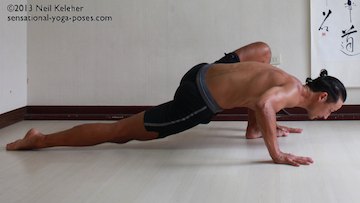
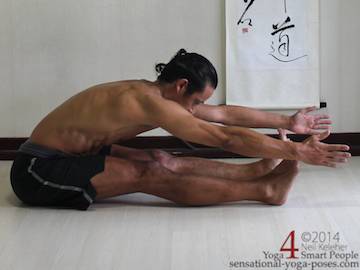
Meanwhile high lunge and upright pigeon are both back bends for the hip.
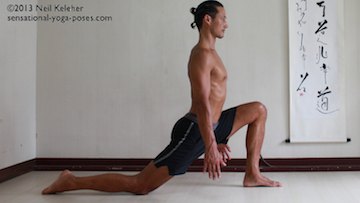
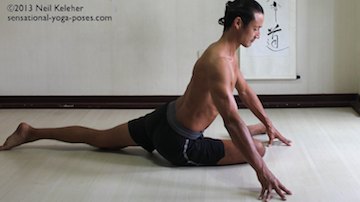
These are all poses that you can use to help improve hip flexiblity and work towards the splits.
For improving coordination it may help first to understand what is required for coordination.
My own understanding is that first you need to know what you are trying to do. You can then try doing it. But then you need to be able to sense what you are doing.
You could use your eyes and a mirror but you could also work towards feeling your body. You can then sense (or see) if what you are doing is wrong or right. You can then correct yourself if wrong.
And that's why you need to know. It provides the basis for assessing wrong or right.
As you practice you get better at matching movement to the idea of what you are doing without having to correct yourself. Your coordination has improved.
(Dance of Shiva offers a simple way to practice hand, arm and shoulder coordination.)
With respect to the splits, coordination can mean first learning what a forward bend and a backward bend is. Then it can mean actually doing those things while noticing what is happening.
To get better at forward bending the hip, practice feeling it. And to change the feeling try contracting the front of the leg, or the back of the leg, or try contracting the muscles to the inside and outside of the leg.
You can try the same "experiments" backbending the hip.
In this case you help to improve coordination by deliberately choosing a muscle or set of muscles to activate (e.g. front of the thigh or back of the thigh). You've gained some coordination when you actually activate the muscles that you chose to activate.
The next problem is figuring out how to put these two actions together to do the splits.
One way to think of flexibility is being able to relax a muscle and stretch it. And so your work can then be learning to relax your hip muscles while forward bending and back bending the hip. So then the challenge is how to keep those muscles relaxed when you are actually working on doing the splits.
One way is to use the arms to support the weight of the body.
If your hands can't touch the floor then use blocks (or books or chairs) so that you can use your hands to help support the weight of your body.
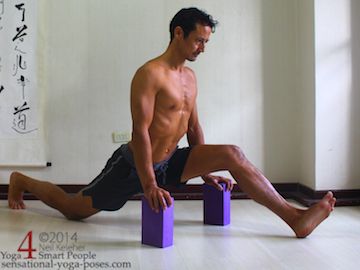
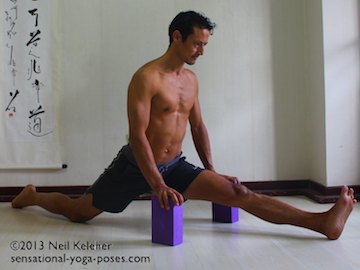
Note you could start with the front knee straight or bent. For "Self Mastery" try both options. In each case you can push forwards through the heel and then rest, then repeat.
You can try the same thing with the back knee. Bent or straight. Or start with it bent then as you focus on reaching the back foot back, then lift and straighten the knee. Bend it and put it back down on the floor again to relax.
Other options include having the back foot pointing back or tuck the toes under. In the latter case, if you lift the knee then you increase the stretch on the back leg.

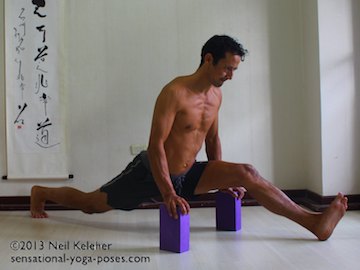
When I learned to control my swearing I didn't just learn to stop swearing I gained the ability to choose when I swore. I became a little bit more free.
By learning to activate different muscles (and feeling them activate) you can experiment with different muscle activations to see if they help you get deeper into the splits.
For myself I went through a phase where activating the muscles at the side of my hips (both for the front leg and the back leg) helped me to get deeper into the splits. But then it changed and I had to experiment to try what else might help. The advantage of this was that I improved both my awareness of my body and my ability to choose how to respond.
In the same way, learning to control swearing didn't just give me better control of swear words, it gave me better control of language as a whole because I was able then to practice being aware of what I said. I could then choose my words in any situation.
As for learning to control various muscles when working towards the splits, that same control can then be used in any other yoga, position or action that you are doing (and it doesn't even have to relate to yoga poses.)
Strength could be thought of as being at the opposite end of the muscle control spectrum from flexibility. Instead of relaxing muscle tissue and stretching it, you are activating muscle tissue.
One way to practice strengthening is to combine it with flexibility training. While you are holding a stretch first contract the muscle being stretched. You help to strengthen it. Then relax the muscle and see if you can go deeper into the stretch. And so that you get better at both relaxing muscle tissue and activating it, repeat both actions, slowly and smoothly.
Going back to the splits example, as you get more comfortable in the splits, you can work on contracting the muscles you are stretching and then relax them. As you get better at making your leg muscles stronger, you may find that you don't have to use your arms to support your body. Instead you use your legs.
So for example, with your arms on the floor (or on blocks) you squeeze your legs. Then you slowly take your hands off of the floor. Then put your hands back down again, use them to support your body and then relax your legs.
A progression from this is to squeeze the legs and then slowly relax them and let your legs slide further apart without using your arms at all.
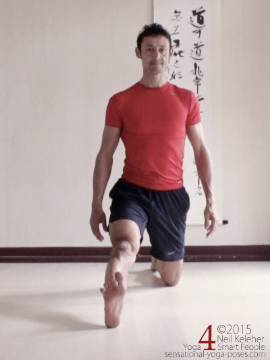
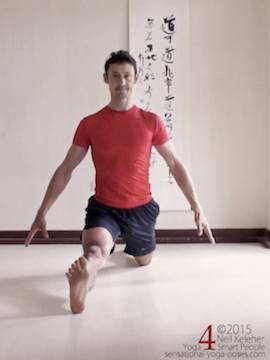
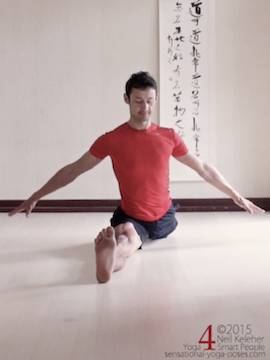
Make it safe to fail. Have blocks handy if you need them and be ready to put your hands down if you find yourself going too far.
As I practiced the splits (and flexibility in general) I found that I had to redefine what it meant to stretch. Initially my focus was on relaxed stretching. But then I reached a limit and it was time to redefine stretching. For me that meant learning to lengthen muscle tissue while it was active.
In the splits this can mean keeping the legs active, but gradually moving deeper into the splits while keeping them active.
(In the swearing context, I first learned how to stop myself from swearing. Afterwards I allowed myself to swear, but now I was conscious of when I swore. I could choose when to swear and when not to.)
With enough practice of relaxing and then activating muscle tissue it then becomes possible to control the muscle in a different way. And for myself that meant active lengthening.
I use active lengthening to get all the way down to the ground and then I play again with relaxing and activating so that eventually I'll be able to do the splits cold.
I didn't stop swearing in a day. You probably won't get super flexible or strong in a day. However, if you work at it consistently you can change.
With practice changing ourselves becomes easier.
Part of practice can mean rather than holding on to preconceived notions, learn to let them go, change them when it is appropriate.
By changing our thoughts we may actually be able to change our body and the way we experience the world around ourselves.
And the nice thing is that rather than becoming a victim or a helpless bystander we take control of the only thing that we can truly control, ourselves.
P.S. One of my current projects is to stop myself from getting involved in facebook posts. (At least the potentially negative ones.) One of my answers to this is to use posts that "excite me" as the basis for articles on my own website.
Anger is perhaps one of the more interesting challenges to deal with. From the self mastery perspective, anger could be looked at as energy that is being inefficiently directed.
And so a possible first step towards anger management is to ask why we are angry. For myself, getting cut off in traffic is an indication that I am not paying attention. Getting upset about someone else's facebook post is a sign that either I need to get off of facebook or write something that ideally benefits myself and others.
As a final note in that regard, I remember reading that the inspiration for The Shining occurred when Stephen King's son threw pages of his maniscript around. This was in the days before computers where commonplace. The way I remember reading it was that King really wanted to kill his kid. Obviously he didn't. But he channeled his rage into something positive, a book that has been read by more than a few people.
